Our Mission
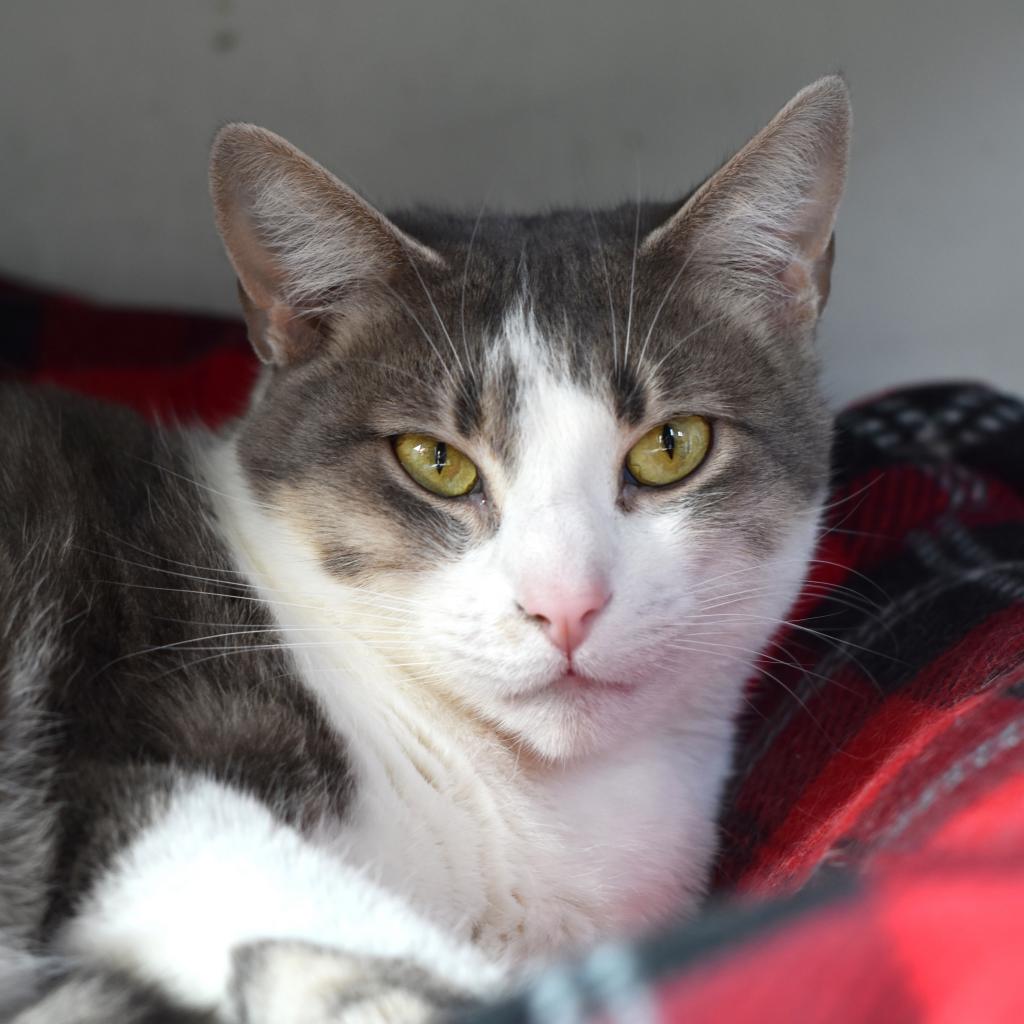
Meet
Pippa
Lonely Hearts Club Member
Pippa has been with CCS longer than any of our other adoptable cats. She lives in our admin building, where she gets all the attention she desires—or doesn’t! A quirky girl, Pippa loves to play, drink water by dipping her paw, steal your chair the moment you step away, and will never let you forget when it’s dinner time.
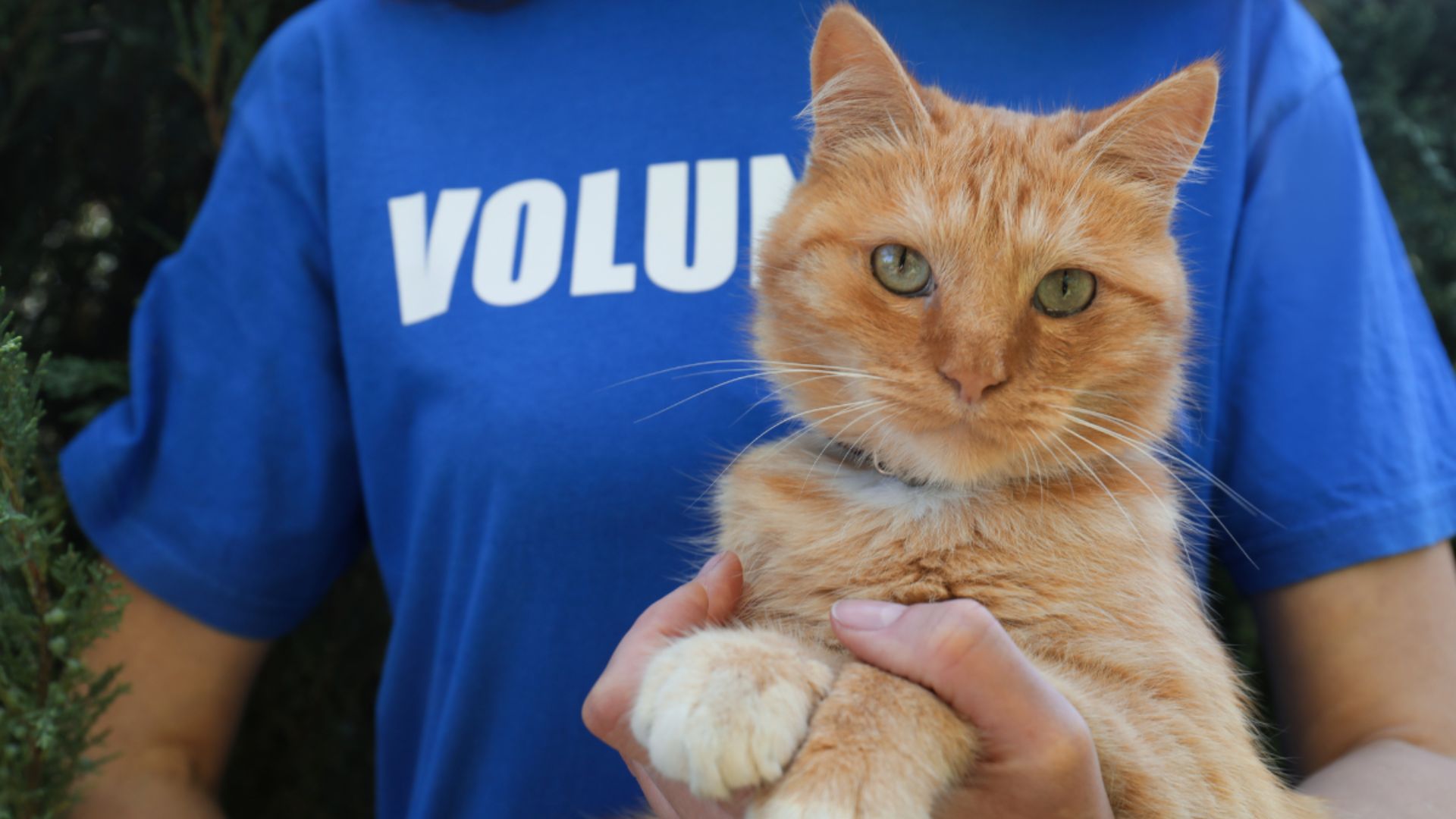
Volunteer
Get involved by giving back! We have many volunteer roles available to help support the cats in our shelter. A few hours can make a world of difference.
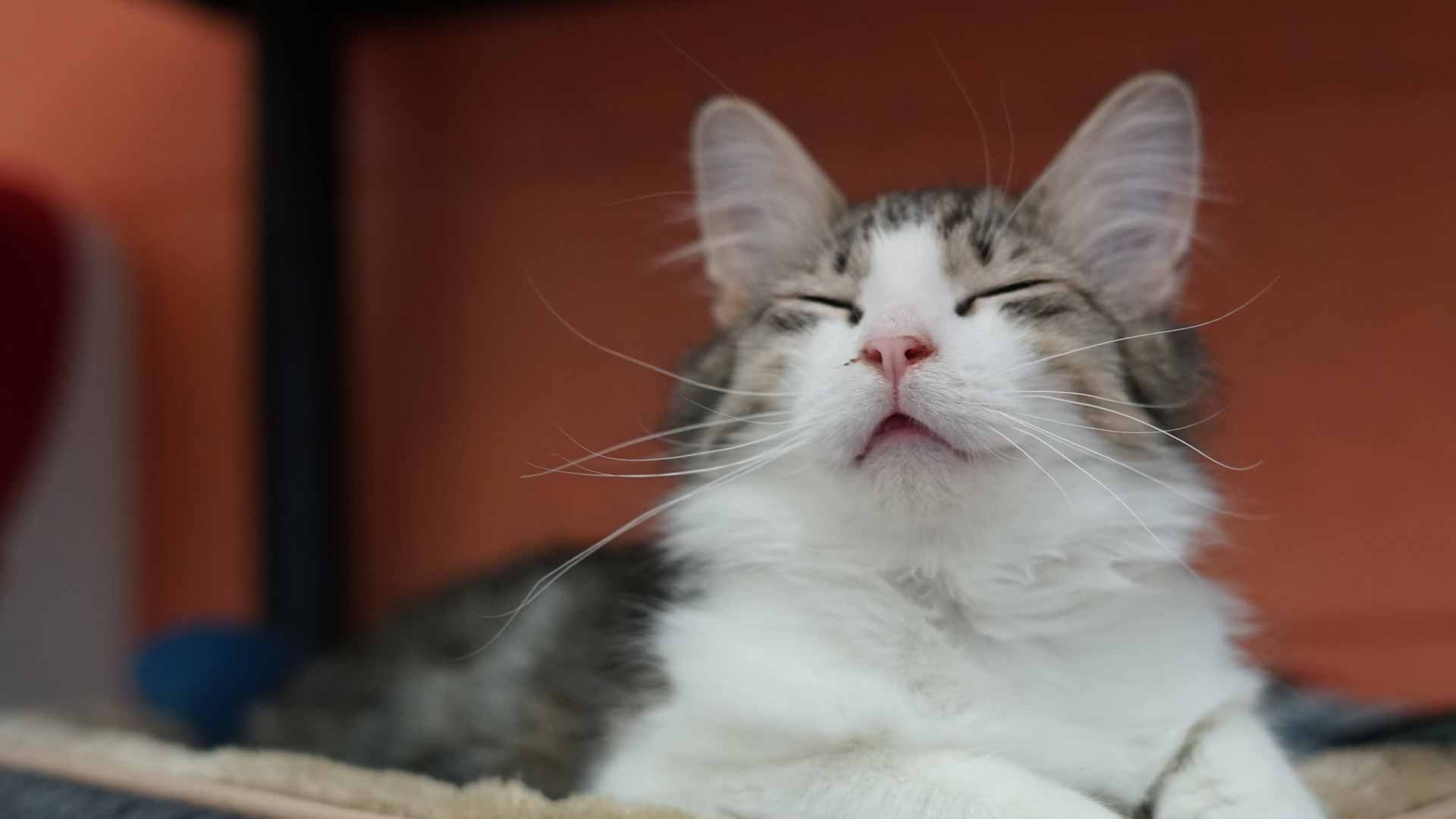
Foster
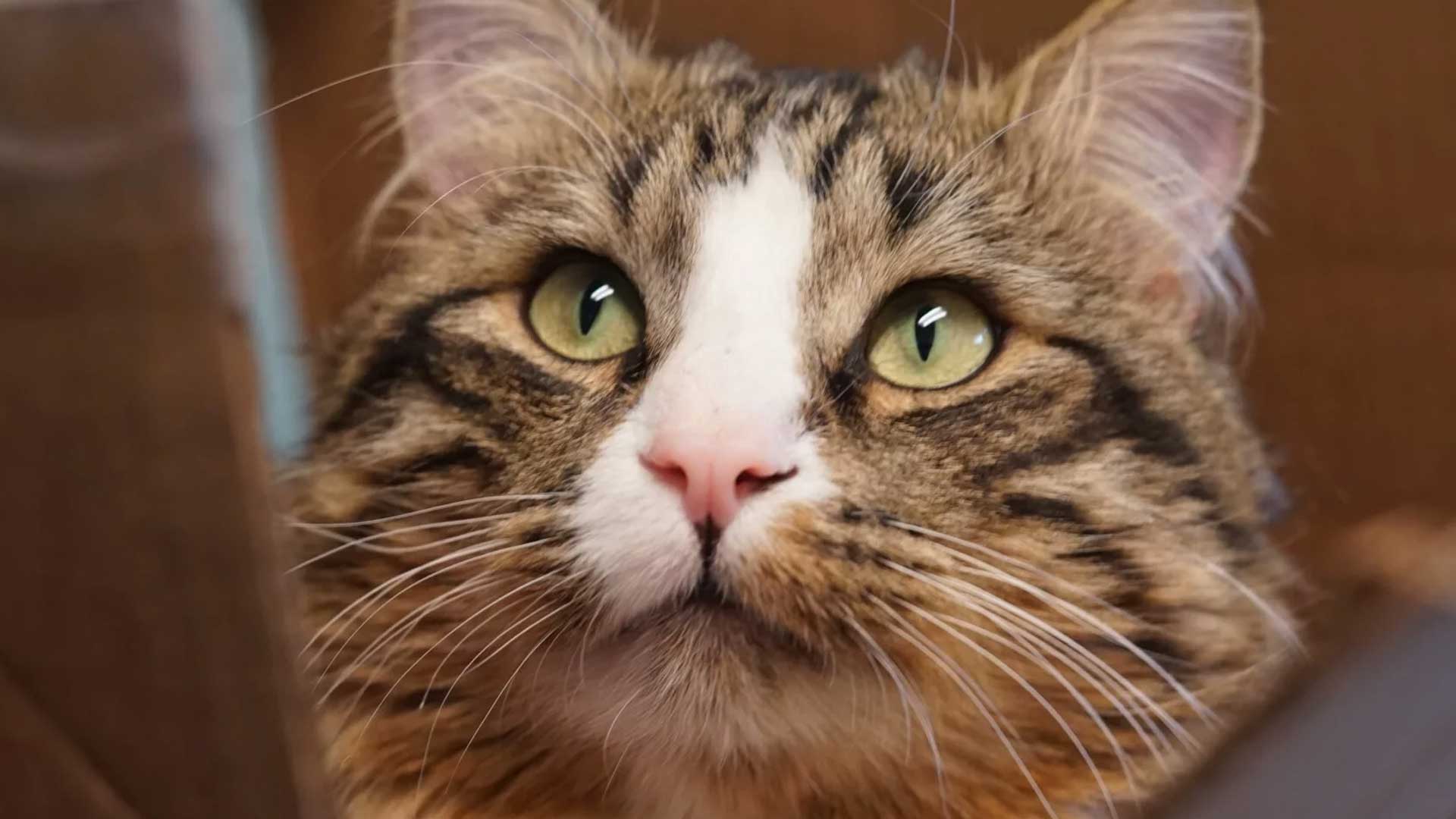
Adopt
Save a life and find your new best friend while opening up more space in the shelter. After picking out your purrfect match, apply to adopt!
Upcoming Events

Tails of the Painted Cats

Santa Paws

Seminar: Clicker Training Your Cats
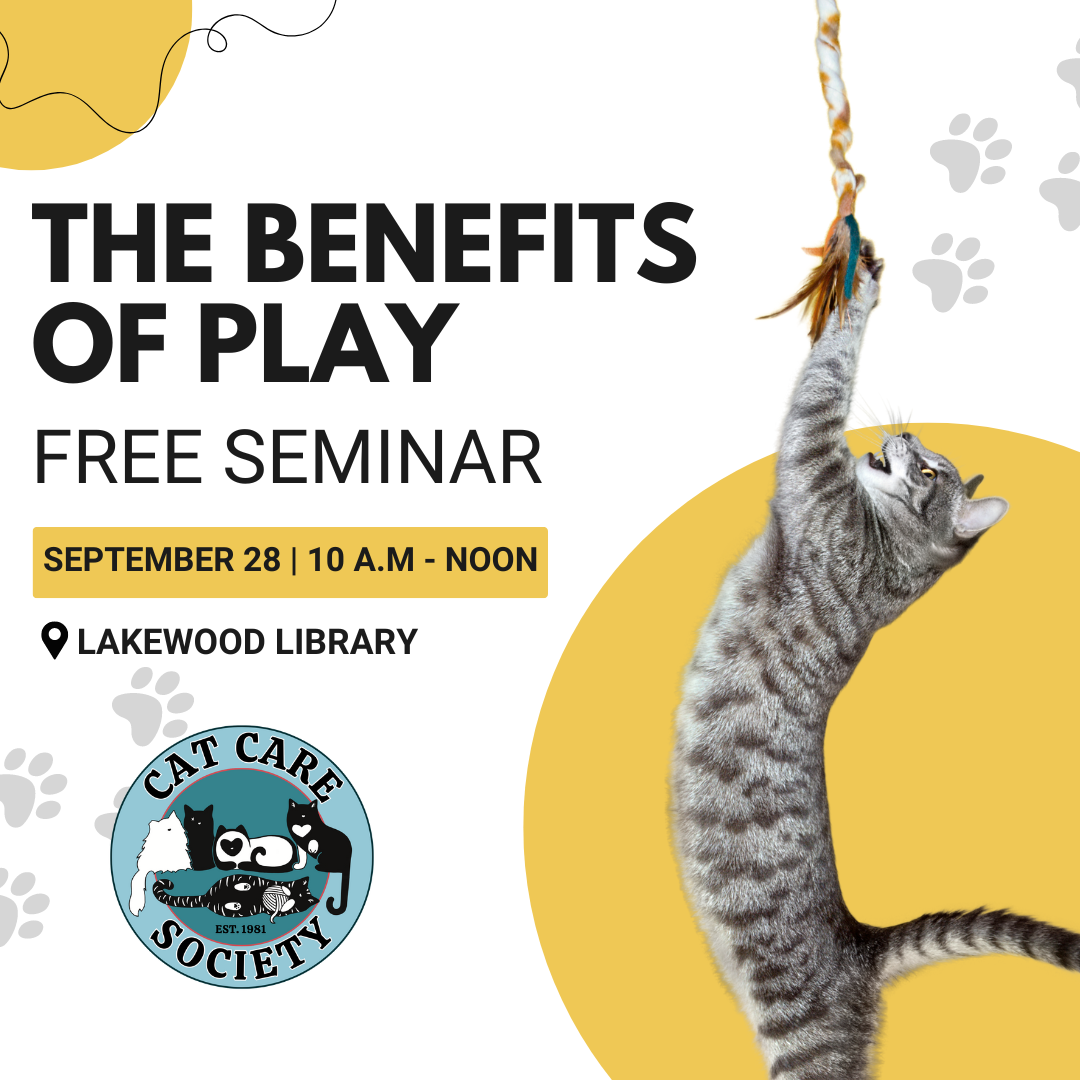
Seminar: The Benefits of Play
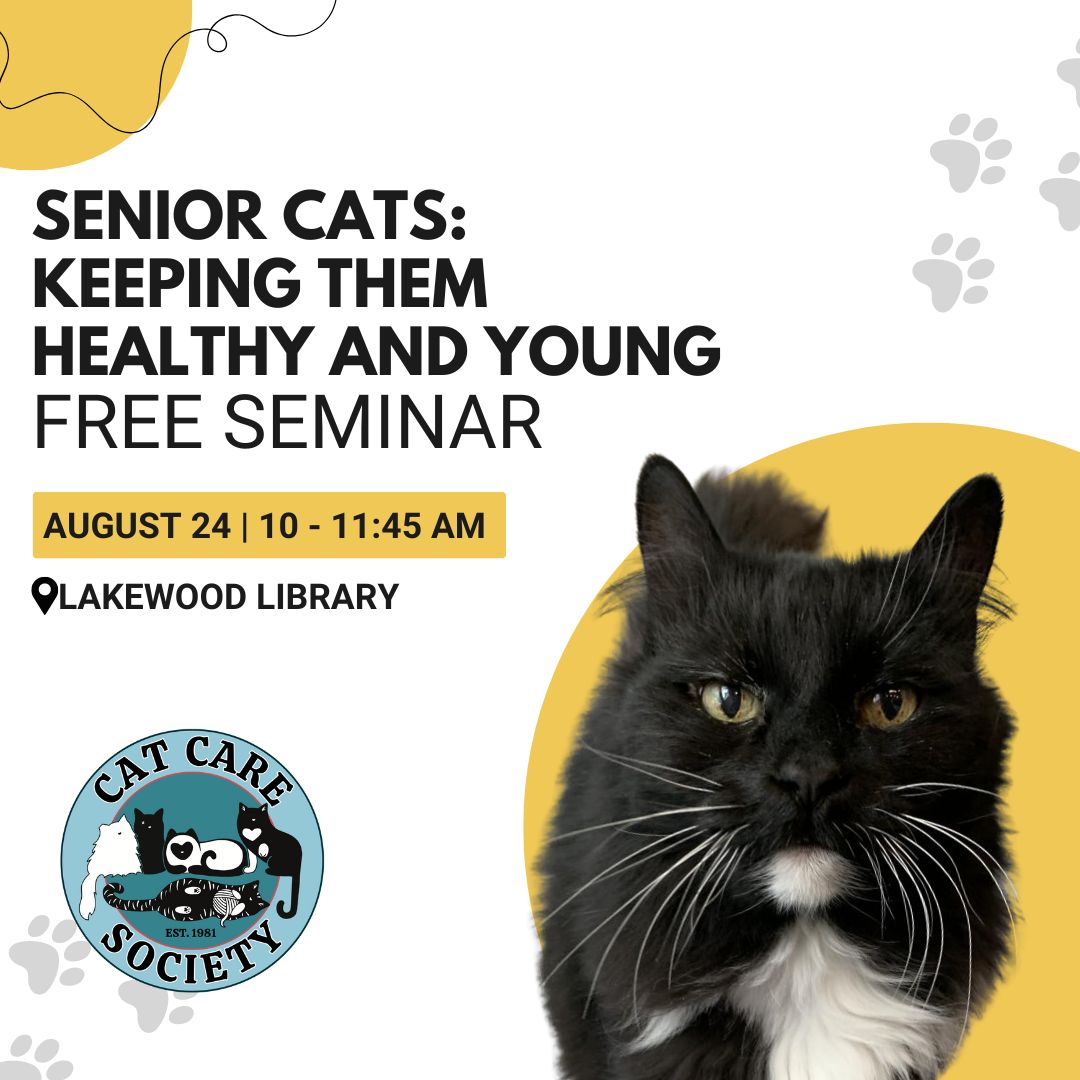
Seminar: Keeping Senior Cats Healthy & Young
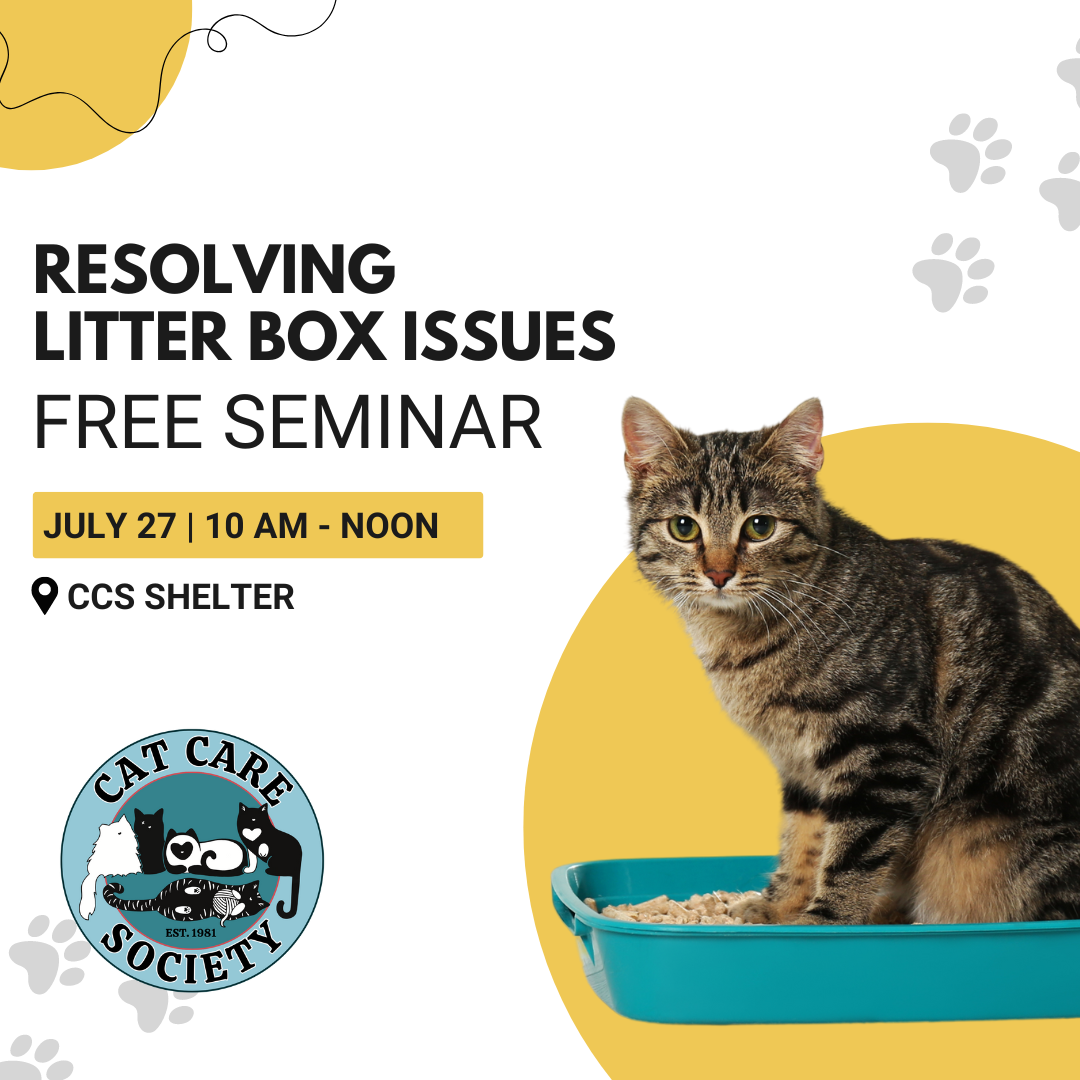
Seminar: Resolving Litter Box Issues

Summer Art Auction (Online)
- Ends August 9, 2024
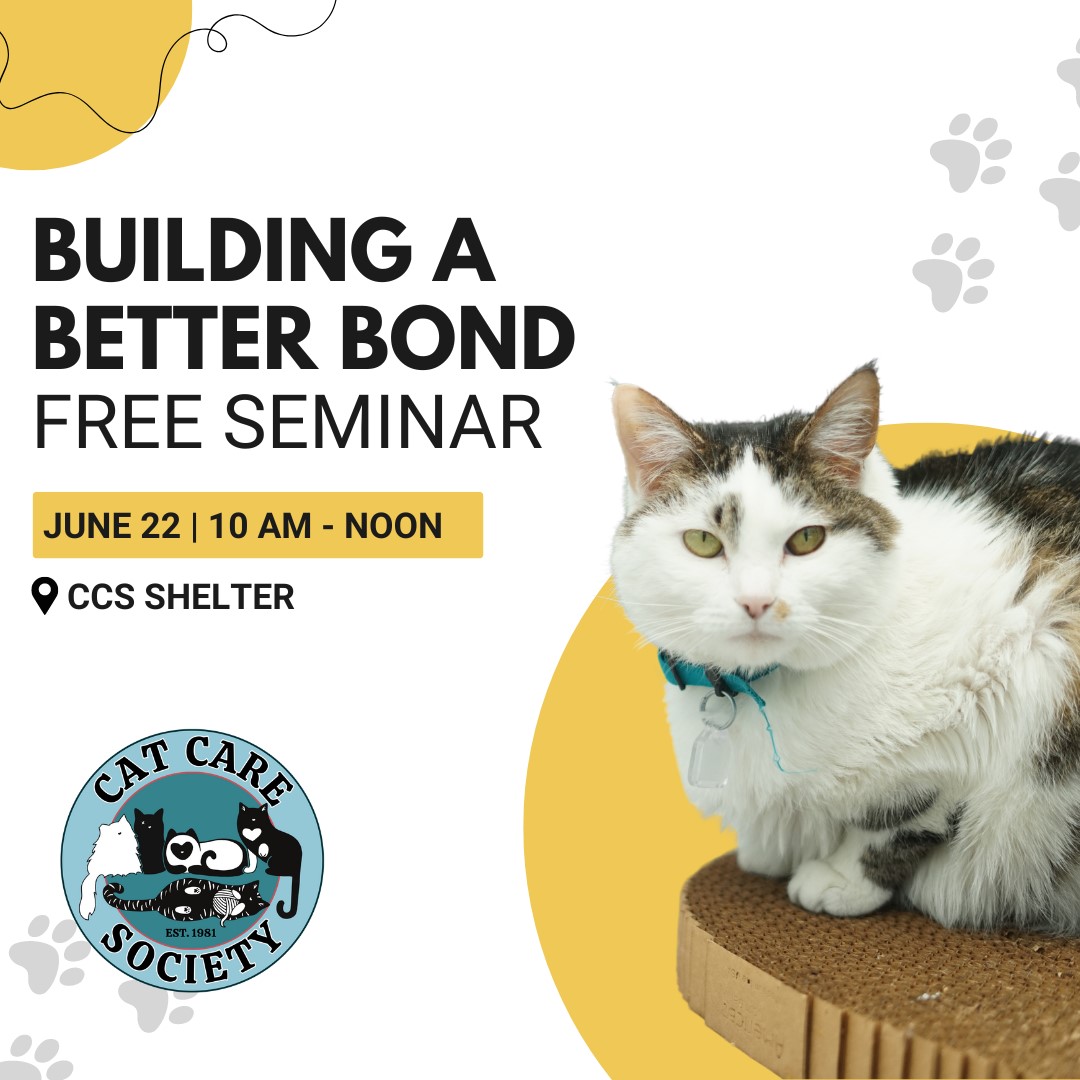
Seminar: Building a Better Bond with Your Kitty
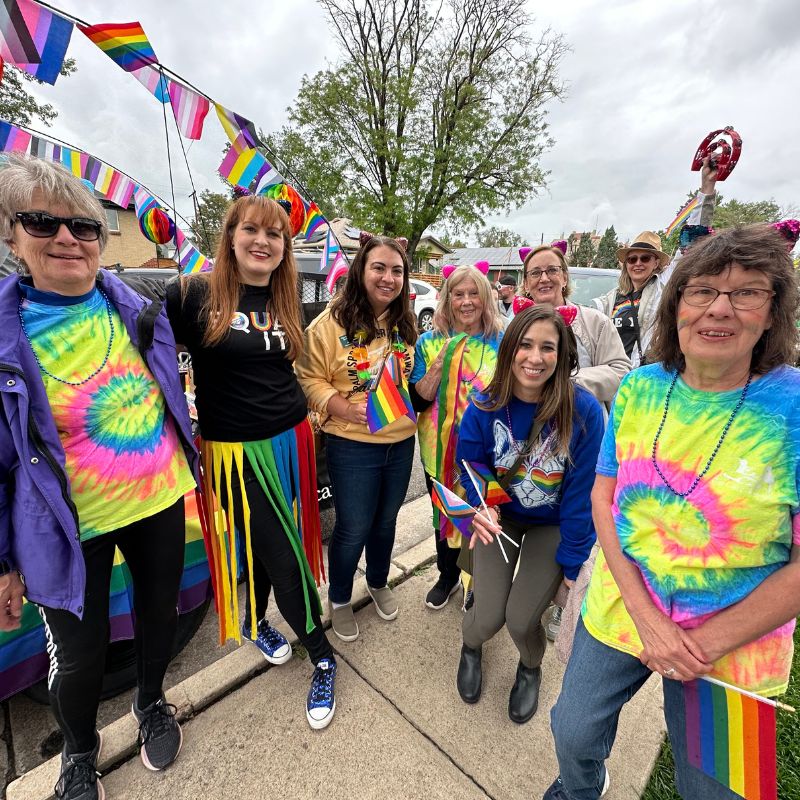
CCS @ Denver PrideFest
- Ends June 23, 2024
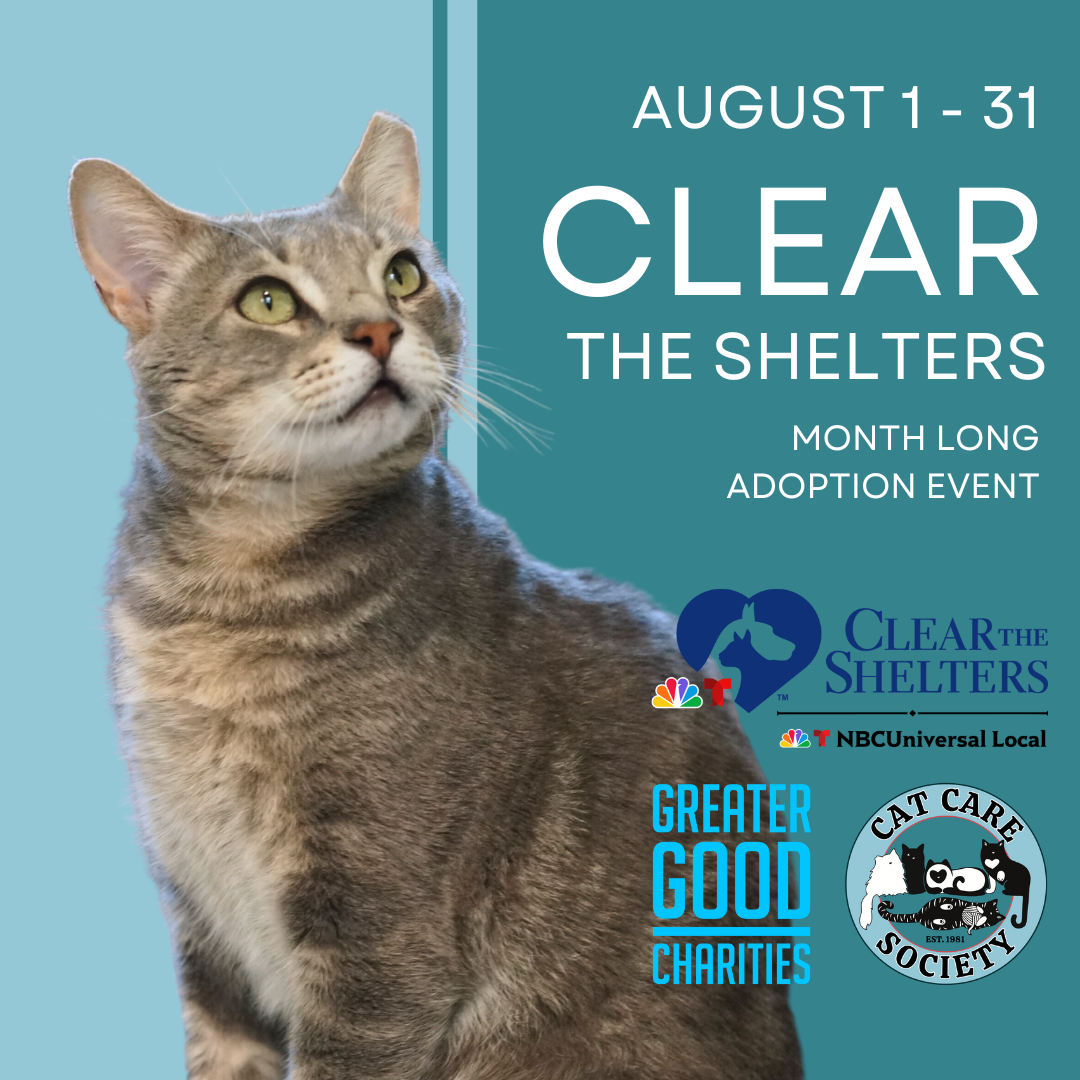
Free Adoption Event & Thrift Shop: Clear the Shelters
The Whisker Whisper Blog
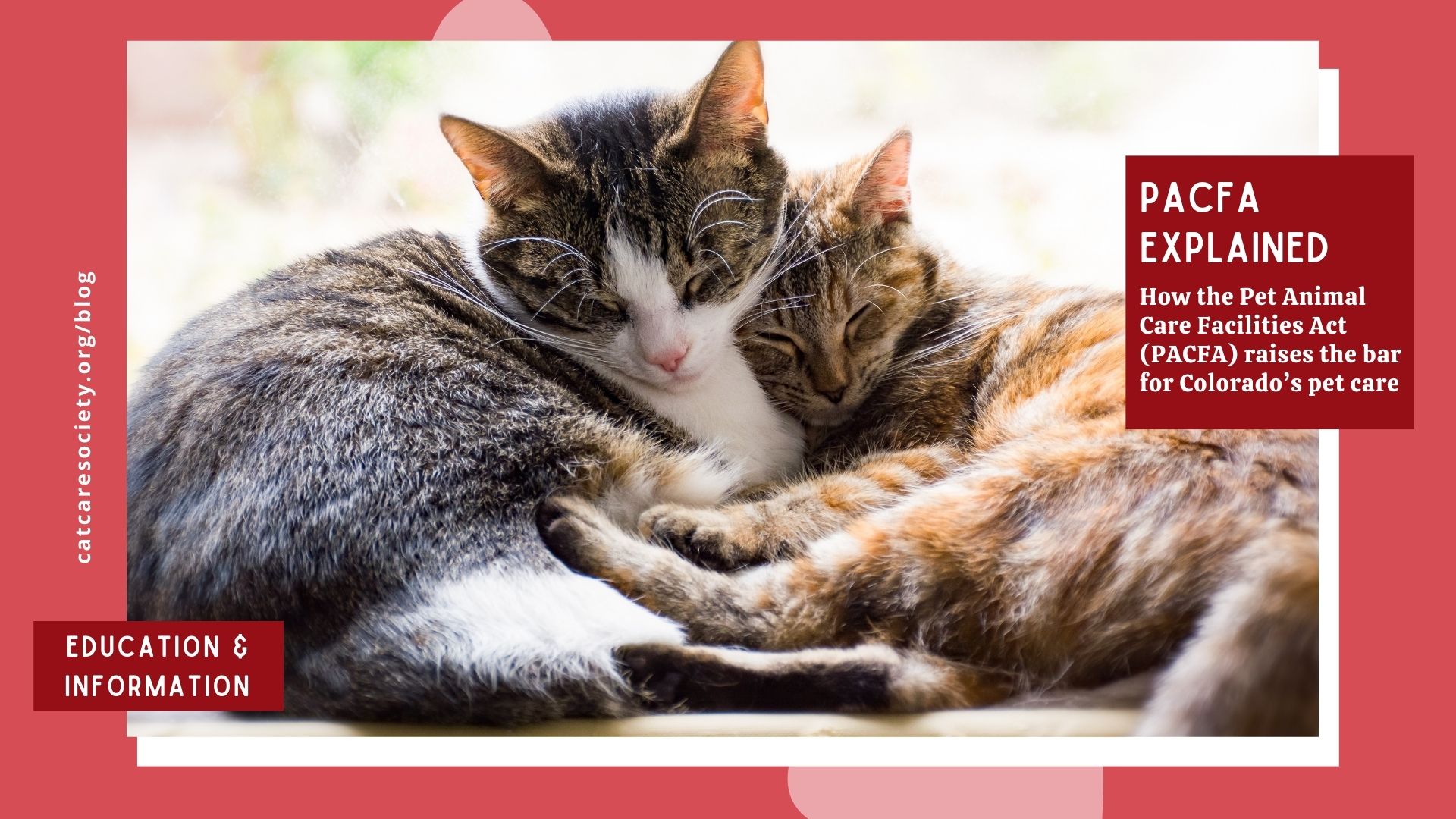
PACFA Explained: How the Pet Animal Care Facilities Act (PACFA) Raises the Bar for Colorado’s Pet Care
Introduction
In Colorado, caring for animals isn’t just a calling—it’s a fundamental responsibility governed by the Pet Animal Care Facilities Act (PACFA). Established in 1994, this program protects the health, safety, and welfare of animals in pet care facilities while also protecting consumers who utilize pet-related services.
Whether someone runs an animal shelter (like we do at Cat Care Society!), a pet grooming business, a breeding operation, or a rescue, PACFA requires a license to legally care for animals. This state law sets comprehensive standards to ensure that animals in licensed facilities receive proper care. Through regular updates and inspections, PACFA prioritizes animal welfare, positioning Colorado as a leader in this field. In this article, we’ll explore the broad and comprehensive scope of PACFA, clarify what it doesn’t cover, and explain why it matters for pets and pet owners across Colorado.
PACFA’s Scope
PACFA is Colorado’s state law that regulates companion animal care facilities, ensuring animals receive proper treatment and live in environments where their physical and emotional needs are met. Some animals covered under PACFA include cats, dogs, birds, guinea pigs, mice, rats, hamsters, gerbils, ferrets, rabbits, reptiles, amphibians, and fish.
One of the strongest aspects of PACFA is its comprehensiveness and level of detail. Below are just some of the areas it covers. Note that requirements are individualized based on animal type.
- Animal housing and enclosures
- Size, based on animal, size, and length of stay
- Material
- Cleanliness
- Sanitation practices
- Food and water
- Storage
- Serving containers
- Access
- Sanitation practices
- Facility standards
- Safe building materials
- Water quality
- Lighting
- Air quality
- Temperature
- Secure enclosures
- Sanitation
- Overall maintenance
- Outdoor access and environment
- When animals must be separated from others based on behavior, type of facility, age of the animal, quantity, and type of the animal
- Animal supervision
- Veterinary care and disease control
- Transportation of animals
- Adoption/sale based on age and weight
- Pregnant and nursing animal care and environment standards
- Foster care requirements
- Contingency planning for natural disasters and other emergencies
- Proactive behavior and enrichment plans
- Recordkeeping related to each individual animal in care
PACFA Compliance and Oversight
The Colorado Department of Agriculture (CDA) is responsible for enforcing PACFA regulations. This oversight ensures that any organization involved in pet care operates with transparency, accountability, and a deep commitment to the animals in their charge. To earn and maintain a PACFA license, facilities like shelters, rescues, pet stores, and groomers must pass rigorous inspections, meet specific criteria on an ongoing basis, and complete annual reporting.
PACFA’s licensing program isn’t just about paperwork—it’s about safeguarding animal welfare. By maintaining a PACFA license, facilities commit to meeting essential standards for animal housing, health, and safety, all under the enforcement of the CDA. And as these standards are regularly updated, shelters and rescues must stay current, adapting to new regulations that reflect the evolving practices in animal care. Additionally, current PACFA licensees must complete a qualifying continued education every two years to stay up-to-date with PACFA’s standards.
What are the differences between an animal shelter, a rescue, and a sanctuary?
While the terms shelter, rescue, and sanctuary are often used interchangeably, the Colorado Department of Agriculture provides distinct legal definitions for each. The Rules and Regulations Pertaining to the Administration and Enforcement of the Pet Animal Care and Facilities Act (8 CCR 1201-11) specify the classifications for various types of animal facilities. At Cat Care Society (CCS), we operate as a private non-profit animal shelter and do not receive any government funding.
- Animal Rescue – any firm, person, or corporation that accepts pet animals for the purpose of finding permanent adoptive homes for these animals and does not maintain a central facility for keeping animals.
- Animal Shelter Facility: any firm, person, or corporation, whether public or private, that houses pet animals for impoundment purposes; or a centralized, private facility that accepts or houses pet animals and whose facilities are self-contained and used exclusively for the purpose of caring for and housing pet animals according to these rules.
- Animal Sanctuary Facility: a subclassification of “animal shelter,” is any private facility that harbors pet animals, that is not used for impoundment purposes, and that is not used exclusively for the purpose of caring for or housing pet animals.
What PACFA Doesn’t Cover
PACFA isn’t animal control or animal protection. Municipal animal control units enforce municipal and state ordinances typically related to private citizen pet ownership, such as dog licensing, leash laws, lost and found, and cruelty/neglect. However, PACFA staff may partner with a local animal control unit if animal cruelty and neglect is discovered.
Additionally, PACFA is required by the state to report animal cruelty and neglect to local law enforcement or the Colorado Bureau of Animal Protection (BAP). BAP conducts outreach and education to prevent neglect and mistreatment of domestic and companion animals in Colorado and follow-up on complaints to help enforce pertinent laws.
PACFA doesn’t oversee licensure of veterinarians or vet techs. The State Board of Veterinary Medicine within Colorado’s Department of Regulatory Medicine regulates and licenses/registers veterinarians and veterinary technicians in the State of Colorado.
Cat Care Society: Raising the Bar
Since 1981 Cat Care Society has been committed to a very simple mission: provide cats with the best possible care until they find their forever homes. We fully comply with PACFA’s standards, and our commitment to evolving with the research behind these regulations reflects our ongoing dedication to providing the best possible care for the cats we serve. But we don’t stop there. We believe every cat deserves a safe, loving environment, regardless of age or medical condition.
From individualized care plans to behavioral enrichment programs and our exceptional volunteer and foster teams, we strive to exceed PACFA’s requirements to make sure each cat is living its best life. That includes having a free-roaming environment for our cats and going above and beyond in evaluating older and special-needs cats to determine the best course of treatment and care.

Why PACFA Matters
PACFA isn’t just about enforcing rules—it’s about creating a culture of responsibility and compassion across the entire pet care field. By ensuring that everyone in the business of caring for animals meets high standards, PACFA guarantees that every cherished pet gets the attention, safety, and love they deserve.
And at Cat Care Society, we’re all about love—our love for cats and our dedication to upholding the values that PACFA instills. Together, with PACFA’s guidance, we’ll continue to make Colorado a better, safer place for animals, one purr at a time.
Use PACFA and CCS Resources to Make Informed Choices
We want all animals to be treated with respect and care which is why we encourage you to reference the PACFA Active Facilities List when selecting a pet care service. The CDA also provides detailed information on their website including data, FAQs, and of course, the full PACFA legislation. Here at CCS, we’re committed to transparency, so on our About Us page, you can find details about how we care for our cats, our latest impact report, our strategic plan, and much more! We also offer an extensive list of recommended pet service providers on our Resources page.
About the Author: Beth Dokolasa is a volunteer for Cat Care Society and serves on the Board of Directors. She is an instructional developer for Natural Grocers and lives in Indian Hills, Colo., with her husband, daughter, and two cats, Techno and Digit.

How Cats Boost Our Health and Happiness in Winter and Beyond
Winter, with its short days and chilly weather, often confines us indoors, making it the perfect season to enjoy the warmth and company of a cat. A field of study known as zooeyia (pronounced zoo-AY-uh) explores the positive impact of human-animal interactions on health, including physical, mental and emotional health. Meaning a cat isn’t just comforting a cozy companion during the colder months, but you share a beneficial, lifelong bond. In this article, we’ll explore the many health benefits to sharing your home with a cat. We’ll also provide some fun activities to enjoy with your cat during a cozy snow day.
Zooeyia: The Healing Power of Pets
Derived from the Greek word for “animal” (zoion) and “health” (Hygeia, the ancient Greek goddess of health), zooeyia encompasses the wide-ranging physical, emotional, and social benefits of owning pets. Cats, as beloved companions, exemplify zooeyia by their ability to:
- Boost Mental Health: Cats have been shown to reduce stress and increase happiness in both adults and children. They often become part of family rituals and conversations, bringing joy and connection among household members. Despite their occasionally aloof expressions, cats don’t judge us. Their calming presence, combined with their warm purrs and cozy lap-sits, playful zoomies and graceful stretches, can instantly lighten our mood. Research supports this: petting a cat lowers cortisol, the stress hormone, and increases oxytocin, a chemical that promotes trust and reduces anxiety. Caring for a cat can also enhance self-esteem and provide emotional support, which helps prevent loneliness and makes life’s struggles easier to manage.
- Support Physical Health: Studies have found that cat owners maintain lower heart rates and blood pressure during stressful tasks and recover faster than non-owners. Additionally, owning a cat is linked to a reduced risk of heart attack and cardiovascular disease—even for those who no longer own a cat but did in the past. These benefits remain significant even when controlling for factors like blood pressure, cholesterol, smoking, and body mass index.
- Promote Physical Activity: Engaging in interactive play with cats keeps both you and your kitty active, even indoors. Not to mention, cats can boost flexibility—they’ll have you bending down to rescue lost toys from under the couch, squatting to clean the litter box, and perfecting your poses as they “help” during yoga sessions!
Fun Indoor Activities to Enjoy with Your Cat
Combat winter monotony by getting creative with your cat! These activities not only enrich your pet’s life but also elevate your mood and strengthen the bond between you and your kitty.
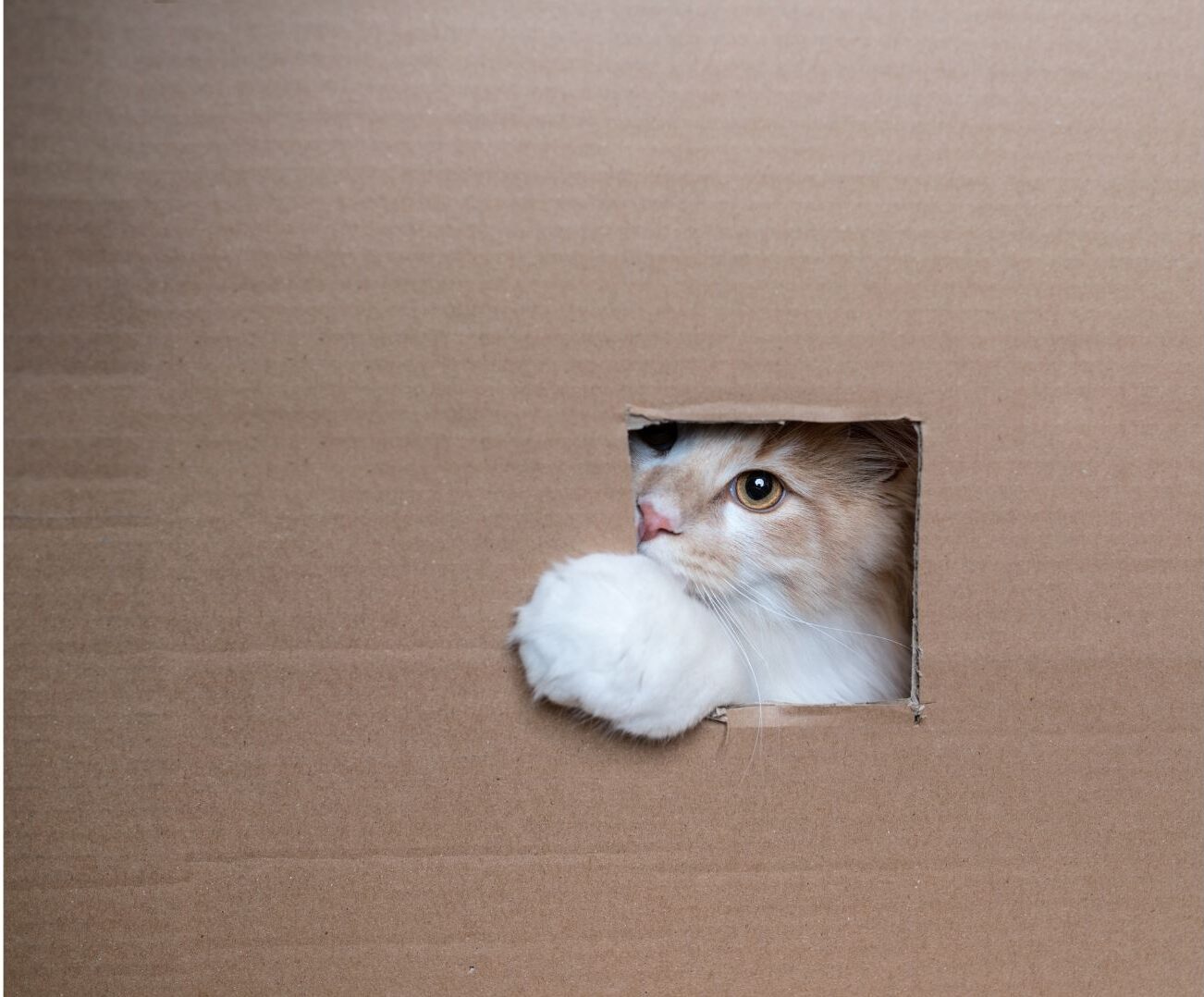
- Build a Pillow Fort: Transform your living room into a cozy playground by constructing a fort with pillows, blankets, and boxes. Most cats love exploring confined, soft spaces, making this a win for both comfort and entertainment.
- Get Crafty With New DIY Toys: Create cat toys with household items, like crumpled paper balls and empty toilet paper rolls, to stimulate your cat’s hunting instincts. Be sure to give your cat a high-protein snack afterwards, which is what they would enjoy after hunting in the wild.
- Watch a Movie Together: Find a bird documentary to stream and watch it with your cat. It’ll provide you both with entertaining mental enrichment.
- Use Extra Indoor Time for Training: Contrary to popular belief, cats can learn tricks, especially when you use clicker training. Use positive reinforcement to teach your cat simple commands like “sit” or “high five.” Clicker training not only engages a cat’s mind but also supports their mental health, making it especially beneficial for cats who are easily stressed.
- Create a Winter Spa Day: Groom your cat with a gentle brushing session, trim their nails, brush their teeth, and take a nap together. This strengthens your bond and keeps them healthy, especially their coat, which is important during the dry winter months.
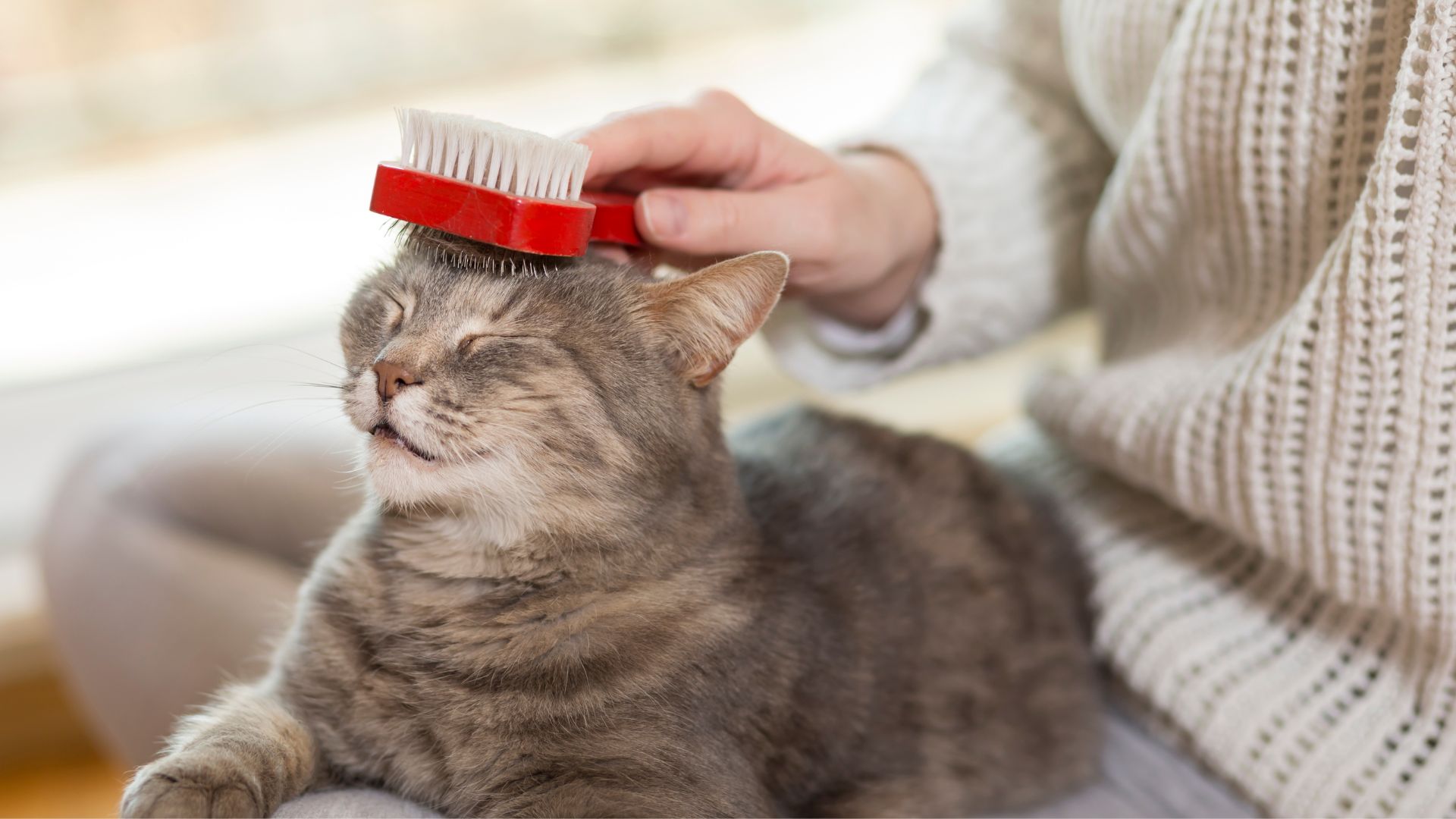
Note that some cats need breaks from physical touch. Read our blog post on overstimulation in cats to learn how to recognize the signs to ensure a positive experience.
Closing Thoughts
Cats offer much more than companionship—they embody the principles of zooeyia by enhancing our mental and physical health, especially in challenging times like winter. Pairing these benefits with fun activities ensures both you and your cat stay happy and engaged. We always have cats available for adoption, so check them out if you’re ready to embrace the warmth and joy they bring to your home (or multiply it if you already have cats!).
About the Author: Beth Dokolasa is a volunteer for Cat Care Society and serves on the Board of Directors. She is an instructional developer for Natural Grocers and lives in Indian Hills, Colo., with her husband, daughter, and two cats, Techno and Digit.
Resources
Allen, K., Blascovich, J., & Mendes, W. (1998). Cardiovascular reactivity and the presence of pets, friends, and spouses: the truth about cats and dogs. International Journal of Psychophysiology, 30(1–2), 116. https://doi.org/10.1016/s0167-8760(98)90295-1
Anderson, K. L., & Olson, J. M. (2015). The value of a pet in enhancing the quality of life. The Journal of the American Board of Family Medicine, 28(4), 526–534. https://www.jabfm.org/content/28/4/526.long
McConnell, A. R., Brown, C. M., Shoda, T. M., Stayton, L. E., & Martin, C. E. (2011). Friends with benefits: On the positive consequences of pet ownership. Journal of Personality and Social Psychology, 101(6), 1239-1252. https://doi.org/10.1037/a0024506
Stammbach, K. B., & Turner, D. C. (1999). Understanding the Human—Cat Relationship: Human Social Support or Attachment. Anthrozoös, 12(3), 162–168. https://doi.org/10.2752/089279399787000237
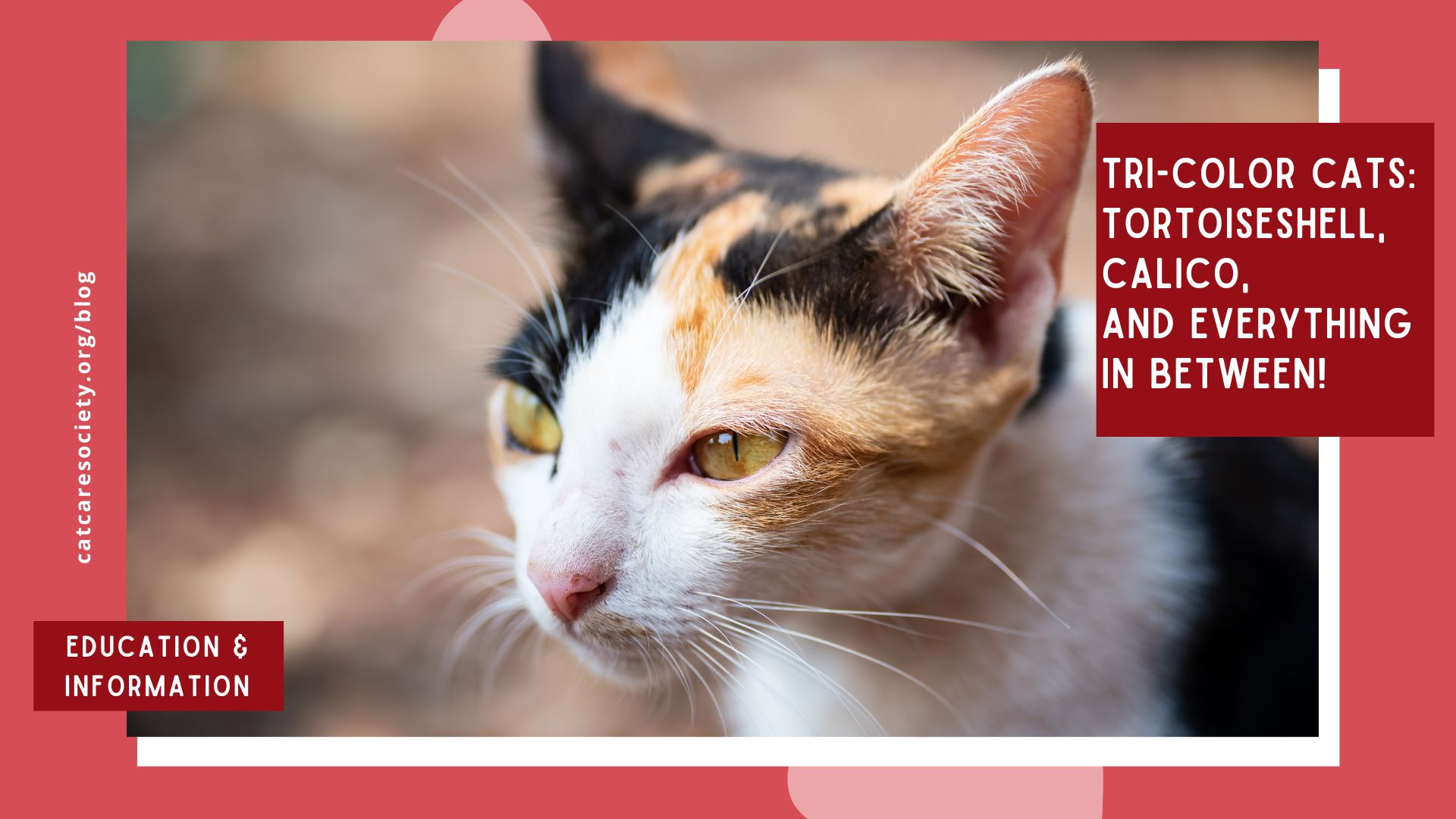
Tri-color Cats: Tortoiseshell, Calico, and Everything In Between!
Introduction
With Halloween approaching, it’s the perfect time to spotlight a particular type of cat—and no, we’re not talking about black cats! Instead, we’re focusing on tri-color cats, whose coats feature a mix of black, orange, and white in varying patterns and ratios. While “tri-color” and “calico” are often used interchangeably, calico cats have a distinct coat pattern. Tortoiseshell cats are also considered tri-color, even though they usually lack white and have their own unique pattern. It’s important to remember that “calico” and “tortoiseshell” refer to coat patterns, not breeds. These color combinations are the result of genetics and can appear in any breed, though they are more commonly found in breeds like American Shorthair, British Shorthair, Japanese Bobtail, Maine Coon, and Persian.
There are also diluted and tabby variations of tortoiseshell and calico cats—so many colorful kitties to love! In the rest of this article, we’ll explore the different markings and patterns that define each type of tri-color coat. By the end, you’ll be able to recognize the unique beauty of every tri-color cat you encounter.
Tri-color Cat Genetics
Tri-color cats are almost always female, with approximately one in 3,000 being male. This is because two X chromosomes are needed to have a distinctive tri-color coat. Typically, if a cat has an XX pair, she will be female. Male cats have an XY chromosome pair, so they’re not tri-color unless they have at least one extra chromosome (XXY). Unfortunately, these males often suffer from Klinefelter’s Syndrome, a condition that can negatively affect their health and longevity.
Calico Cats and Their Variations
Calico cat coats feature patches of solid orange, black, and white. The white color is a result of a genetic condition called piebalding, which occurs in a range of other domestic and farm animals. In a diluted calico, the colors are more muted to cream, gray, and white, due to a gene inherited from one of the parents that diminishes color intensity.

“Tabico” is a term for cats that have a combination of tabby and calico markings. These cats have large patches of orange and black on a white background, with tabby stripes overlaying some of the black and orange areas. When tabby stripes cover the forehead, they form the distinctive “tabby M.” A diluted tabico’s coat features cream, gray, and white fur.
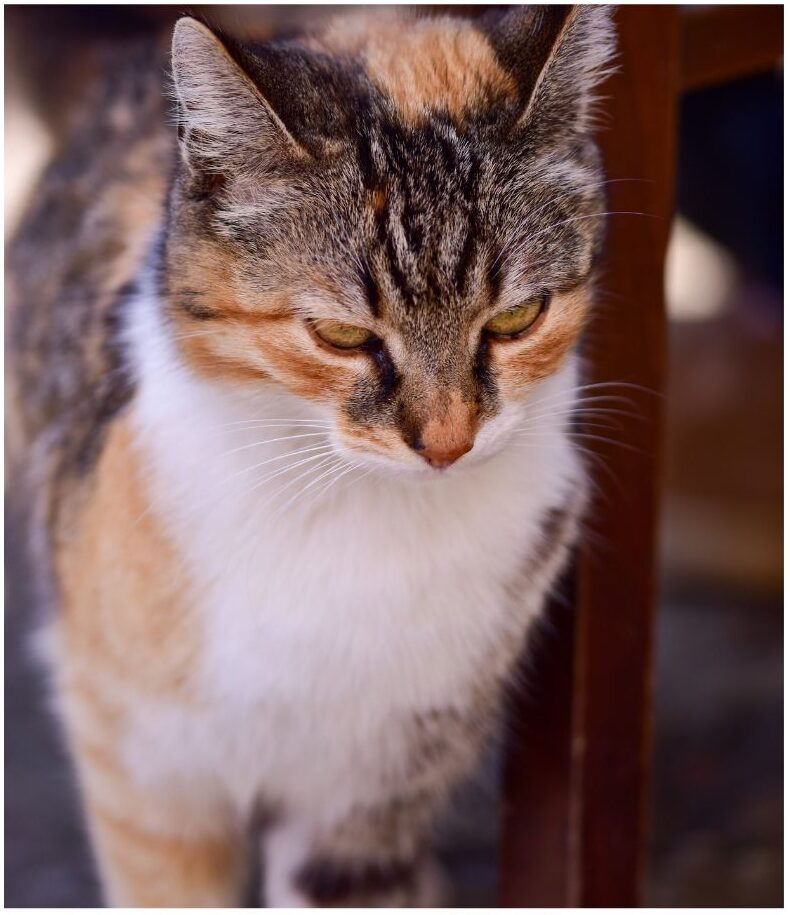
Tortoiseshell Cats and Their Variations
Tortoiseshell, or “tortie,” cats have brindle patterns (irregular stripes or streaks) of orange and black with little to no white. A diluted tortie has gray and cream colors and is a result of both parents carrying a recessive gene that impacts the intensity of the colors.
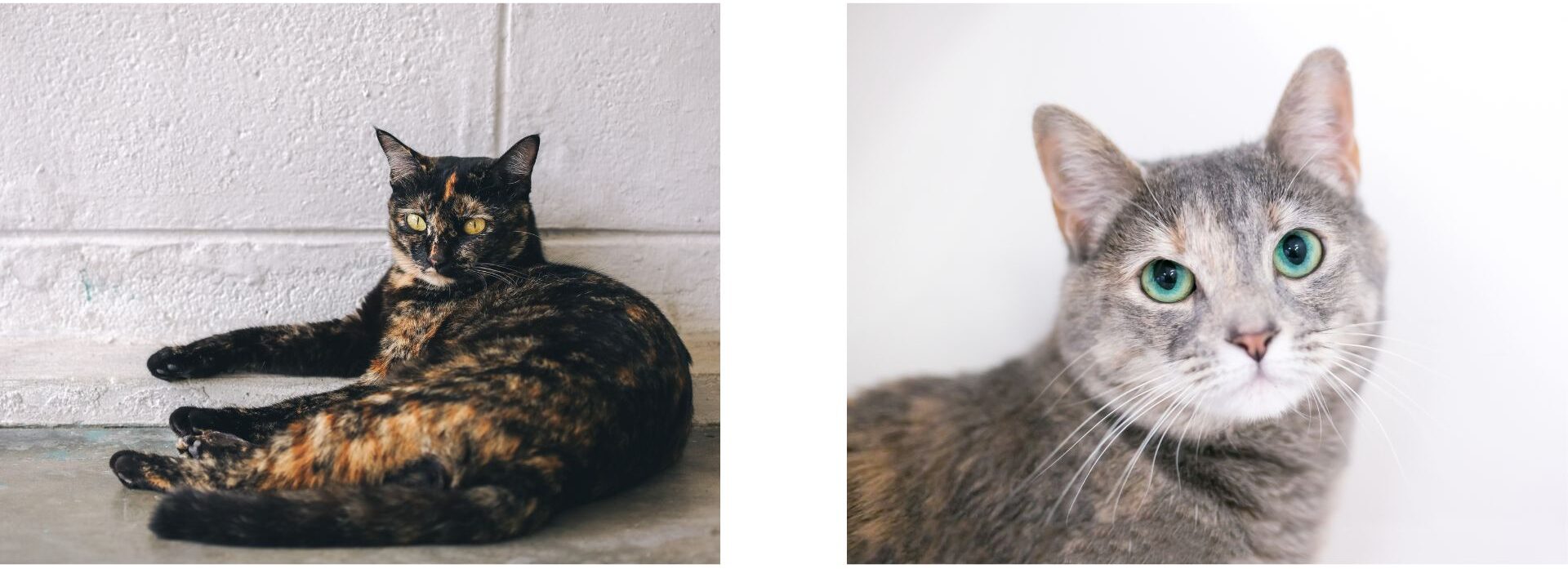
A torbie cat exhibits both the multi-colored brindle pattern of a tortoiseshell cat and the characteristic stripes or spots of a tabby. Like the tabico, if there are tabby stripes on the cat’s forehead, they will display the “tabby M.” Diluted torbies usually have a cream, gray and white coat.
Tortico: A Unique Blend
A “tortico” is a combination of classic tortie and calico markings, featuring large patches of orange and black brindling on a white background. A diluted tortico is relatively rare, and will be gray and cream, and white.

Closing and Final Fun Facts!
As you can see, there are many variations of tri-color cats but you can still count yourself lucky if you run into one! In many cultures tri-color cats are connected with good luck and good fortune, and in the U.S., they are sometimes called “money cats.”
People who have tri-color cats often report that they’re equally sweet and sassy and tortoiseshell cat owners often refer to their feisty side as having “tortitude.” However, since tri-color cats aren’t a breed, research hasn’t been able to confirm that this extra feistiness is a distinct trait related to their coat pattern. That said, if you haven’t taken our “Whats Your Cat Purrsonality” quiz on our Just Fur Fun page, now’s your chance! Discover which cat breed or color pattern best represents you—maybe even find out if you have a bit of tortitude!”
About the Author: Beth Dokolasa is a volunteer for Cat Care Society and serves on the Board of Directors. She is an instructional developer for Natural Grocers and lives in Indian Hills, Colo., with her husband, daughter, and two cats, Techno and Digit.

PACFA Explained: How the Pet Animal Care Facilities Act (PACFA) Raises the Bar for Colorado’s Pet Care
Introduction
In Colorado, caring for animals isn’t just a calling—it’s a fundamental responsibility governed by the Pet Animal Care Facilities Act (PACFA). Established in 1994, this program protects the health, safety, and welfare of animals in pet care facilities while also protecting consumers who utilize pet-related services.
Whether someone runs an animal shelter (like we do at Cat Care Society!), a pet grooming business, a breeding operation, or a rescue, PACFA requires a license to legally care for animals. This state law sets comprehensive standards to ensure that animals in licensed facilities receive proper care. Through regular updates and inspections, PACFA prioritizes animal welfare, positioning Colorado as a leader in this field. In this article, we’ll explore the broad and comprehensive scope of PACFA, clarify what it doesn’t cover, and explain why it matters for pets and pet owners across Colorado.
PACFA’s Scope
PACFA is Colorado’s state law that regulates companion animal care facilities, ensuring animals receive proper treatment and live in environments where their physical and emotional needs are met. Some animals covered under PACFA include cats, dogs, birds, guinea pigs, mice, rats, hamsters, gerbils, ferrets, rabbits, reptiles, amphibians, and fish.
One of the strongest aspects of PACFA is its comprehensiveness and level of detail. Below are just some of the areas it covers. Note that requirements are individualized based on animal type.
- Animal housing and enclosures
- Size, based on animal, size, and length of stay
- Material
- Cleanliness
- Sanitation practices
- Food and water
- Storage
- Serving containers
- Access
- Sanitation practices
- Facility standards
- Safe building materials
- Water quality
- Lighting
- Air quality
- Temperature
- Secure enclosures
- Sanitation
- Overall maintenance
- Outdoor access and environment
- When animals must be separated from others based on behavior, type of facility, age of the animal, quantity, and type of the animal
- Animal supervision
- Veterinary care and disease control
- Transportation of animals
- Adoption/sale based on age and weight
- Pregnant and nursing animal care and environment standards
- Foster care requirements
- Contingency planning for natural disasters and other emergencies
- Proactive behavior and enrichment plans
- Recordkeeping related to each individual animal in care
PACFA Compliance and Oversight
The Colorado Department of Agriculture (CDA) is responsible for enforcing PACFA regulations. This oversight ensures that any organization involved in pet care operates with transparency, accountability, and a deep commitment to the animals in their charge. To earn and maintain a PACFA license, facilities like shelters, rescues, pet stores, and groomers must pass rigorous inspections, meet specific criteria on an ongoing basis, and complete annual reporting.
PACFA’s licensing program isn’t just about paperwork—it’s about safeguarding animal welfare. By maintaining a PACFA license, facilities commit to meeting essential standards for animal housing, health, and safety, all under the enforcement of the CDA. And as these standards are regularly updated, shelters and rescues must stay current, adapting to new regulations that reflect the evolving practices in animal care. Additionally, current PACFA licensees must complete a qualifying continued education every two years to stay up-to-date with PACFA’s standards.
What are the differences between an animal shelter, a rescue, and a sanctuary?
While the terms shelter, rescue, and sanctuary are often used interchangeably, the Colorado Department of Agriculture provides distinct legal definitions for each. The Rules and Regulations Pertaining to the Administration and Enforcement of the Pet Animal Care and Facilities Act (8 CCR 1201-11) specify the classifications for various types of animal facilities. At Cat Care Society (CCS), we operate as a private non-profit animal shelter and do not receive any government funding.
- Animal Rescue – any firm, person, or corporation that accepts pet animals for the purpose of finding permanent adoptive homes for these animals and does not maintain a central facility for keeping animals.
- Animal Shelter Facility: any firm, person, or corporation, whether public or private, that houses pet animals for impoundment purposes; or a centralized, private facility that accepts or houses pet animals and whose facilities are self-contained and used exclusively for the purpose of caring for and housing pet animals according to these rules.
- Animal Sanctuary Facility: a subclassification of “animal shelter,” is any private facility that harbors pet animals, that is not used for impoundment purposes, and that is not used exclusively for the purpose of caring for or housing pet animals.
What PACFA Doesn’t Cover
PACFA isn’t animal control or animal protection. Municipal animal control units enforce municipal and state ordinances typically related to private citizen pet ownership, such as dog licensing, leash laws, lost and found, and cruelty/neglect. However, PACFA staff may partner with a local animal control unit if animal cruelty and neglect is discovered.
Additionally, PACFA is required by the state to report animal cruelty and neglect to local law enforcement or the Colorado Bureau of Animal Protection (BAP). BAP conducts outreach and education to prevent neglect and mistreatment of domestic and companion animals in Colorado and follow-up on complaints to help enforce pertinent laws.
PACFA doesn’t oversee licensure of veterinarians or vet techs. The State Board of Veterinary Medicine within Colorado’s Department of Regulatory Medicine regulates and licenses/registers veterinarians and veterinary technicians in the State of Colorado.
Cat Care Society: Raising the Bar
Since 1981 Cat Care Society has been committed to a very simple mission: provide cats with the best possible care until they find their forever homes. We fully comply with PACFA’s standards, and our commitment to evolving with the research behind these regulations reflects our ongoing dedication to providing the best possible care for the cats we serve. But we don’t stop there. We believe every cat deserves a safe, loving environment, regardless of age or medical condition.
From individualized care plans to behavioral enrichment programs and our exceptional volunteer and foster teams, we strive to exceed PACFA’s requirements to make sure each cat is living its best life. That includes having a free-roaming environment for our cats and going above and beyond in evaluating older and special-needs cats to determine the best course of treatment and care.

Why PACFA Matters
PACFA isn’t just about enforcing rules—it’s about creating a culture of responsibility and compassion across the entire pet care field. By ensuring that everyone in the business of caring for animals meets high standards, PACFA guarantees that every cherished pet gets the attention, safety, and love they deserve.
And at Cat Care Society, we’re all about love—our love for cats and our dedication to upholding the values that PACFA instills. Together, with PACFA’s guidance, we’ll continue to make Colorado a better, safer place for animals, one purr at a time.
Use PACFA and CCS Resources to Make Informed Choices
We want all animals to be treated with respect and care which is why we encourage you to reference the PACFA Active Facilities List when selecting a pet care service. The CDA also provides detailed information on their website including data, FAQs, and of course, the full PACFA legislation. Here at CCS, we’re committed to transparency, so on our About Us page, you can find details about how we care for our cats, our latest impact report, our strategic plan, and much more! We also offer an extensive list of recommended pet service providers on our Resources page.
About the Author: Beth Dokolasa is a volunteer for Cat Care Society and serves on the Board of Directors. She is an instructional developer for Natural Grocers and lives in Indian Hills, Colo., with her husband, daughter, and two cats, Techno and Digit.

How Cats Boost Our Health and Happiness in Winter and Beyond
Winter, with its short days and chilly weather, often confines us indoors, making it the perfect season to enjoy the warmth and company of a cat. A field of study known as zooeyia (pronounced zoo-AY-uh) explores the positive impact of human-animal interactions on health, including physical, mental and emotional health. Meaning a cat isn’t just comforting a cozy companion during the colder months, but you share a beneficial, lifelong bond. In this article, we’ll explore the many health benefits to sharing your home with a cat. We’ll also provide some fun activities to enjoy with your cat during a cozy snow day.
Zooeyia: The Healing Power of Pets
Derived from the Greek word for “animal” (zoion) and “health” (Hygeia, the ancient Greek goddess of health), zooeyia encompasses the wide-ranging physical, emotional, and social benefits of owning pets. Cats, as beloved companions, exemplify zooeyia by their ability to:
- Boost Mental Health: Cats have been shown to reduce stress and increase happiness in both adults and children. They often become part of family rituals and conversations, bringing joy and connection among household members. Despite their occasionally aloof expressions, cats don’t judge us. Their calming presence, combined with their warm purrs and cozy lap-sits, playful zoomies and graceful stretches, can instantly lighten our mood. Research supports this: petting a cat lowers cortisol, the stress hormone, and increases oxytocin, a chemical that promotes trust and reduces anxiety. Caring for a cat can also enhance self-esteem and provide emotional support, which helps prevent loneliness and makes life’s struggles easier to manage.
- Support Physical Health: Studies have found that cat owners maintain lower heart rates and blood pressure during stressful tasks and recover faster than non-owners. Additionally, owning a cat is linked to a reduced risk of heart attack and cardiovascular disease—even for those who no longer own a cat but did in the past. These benefits remain significant even when controlling for factors like blood pressure, cholesterol, smoking, and body mass index.
- Promote Physical Activity: Engaging in interactive play with cats keeps both you and your kitty active, even indoors. Not to mention, cats can boost flexibility—they’ll have you bending down to rescue lost toys from under the couch, squatting to clean the litter box, and perfecting your poses as they “help” during yoga sessions!
Fun Indoor Activities to Enjoy with Your Cat
Combat winter monotony by getting creative with your cat! These activities not only enrich your pet’s life but also elevate your mood and strengthen the bond between you and your kitty.

- Build a Pillow Fort: Transform your living room into a cozy playground by constructing a fort with pillows, blankets, and boxes. Most cats love exploring confined, soft spaces, making this a win for both comfort and entertainment.
- Get Crafty With New DIY Toys: Create cat toys with household items, like crumpled paper balls and empty toilet paper rolls, to stimulate your cat’s hunting instincts. Be sure to give your cat a high-protein snack afterwards, which is what they would enjoy after hunting in the wild.
- Watch a Movie Together: Find a bird documentary to stream and watch it with your cat. It’ll provide you both with entertaining mental enrichment.
- Use Extra Indoor Time for Training: Contrary to popular belief, cats can learn tricks, especially when you use clicker training. Use positive reinforcement to teach your cat simple commands like “sit” or “high five.” Clicker training not only engages a cat’s mind but also supports their mental health, making it especially beneficial for cats who are easily stressed.
- Create a Winter Spa Day: Groom your cat with a gentle brushing session, trim their nails, brush their teeth, and take a nap together. This strengthens your bond and keeps them healthy, especially their coat, which is important during the dry winter months.

Note that some cats need breaks from physical touch. Read our blog post on overstimulation in cats to learn how to recognize the signs to ensure a positive experience.
Closing Thoughts
Cats offer much more than companionship—they embody the principles of zooeyia by enhancing our mental and physical health, especially in challenging times like winter. Pairing these benefits with fun activities ensures both you and your cat stay happy and engaged. We always have cats available for adoption, so check them out if you’re ready to embrace the warmth and joy they bring to your home (or multiply it if you already have cats!).
About the Author: Beth Dokolasa is a volunteer for Cat Care Society and serves on the Board of Directors. She is an instructional developer for Natural Grocers and lives in Indian Hills, Colo., with her husband, daughter, and two cats, Techno and Digit.
Resources
Allen, K., Blascovich, J., & Mendes, W. (1998). Cardiovascular reactivity and the presence of pets, friends, and spouses: the truth about cats and dogs. International Journal of Psychophysiology, 30(1–2), 116. https://doi.org/10.1016/s0167-8760(98)90295-1
Anderson, K. L., & Olson, J. M. (2015). The value of a pet in enhancing the quality of life. The Journal of the American Board of Family Medicine, 28(4), 526–534. https://www.jabfm.org/content/28/4/526.long
McConnell, A. R., Brown, C. M., Shoda, T. M., Stayton, L. E., & Martin, C. E. (2011). Friends with benefits: On the positive consequences of pet ownership. Journal of Personality and Social Psychology, 101(6), 1239-1252. https://doi.org/10.1037/a0024506
Stammbach, K. B., & Turner, D. C. (1999). Understanding the Human—Cat Relationship: Human Social Support or Attachment. Anthrozoös, 12(3), 162–168. https://doi.org/10.2752/089279399787000237

Tri-color Cats: Tortoiseshell, Calico, and Everything In Between!
Introduction
With Halloween approaching, it’s the perfect time to spotlight a particular type of cat—and no, we’re not talking about black cats! Instead, we’re focusing on tri-color cats, whose coats feature a mix of black, orange, and white in varying patterns and ratios. While “tri-color” and “calico” are often used interchangeably, calico cats have a distinct coat pattern. Tortoiseshell cats are also considered tri-color, even though they usually lack white and have their own unique pattern. It’s important to remember that “calico” and “tortoiseshell” refer to coat patterns, not breeds. These color combinations are the result of genetics and can appear in any breed, though they are more commonly found in breeds like American Shorthair, British Shorthair, Japanese Bobtail, Maine Coon, and Persian.
There are also diluted and tabby variations of tortoiseshell and calico cats—so many colorful kitties to love! In the rest of this article, we’ll explore the different markings and patterns that define each type of tri-color coat. By the end, you’ll be able to recognize the unique beauty of every tri-color cat you encounter.
Tri-color Cat Genetics
Tri-color cats are almost always female, with approximately one in 3,000 being male. This is because two X chromosomes are needed to have a distinctive tri-color coat. Typically, if a cat has an XX pair, she will be female. Male cats have an XY chromosome pair, so they’re not tri-color unless they have at least one extra chromosome (XXY). Unfortunately, these males often suffer from Klinefelter’s Syndrome, a condition that can negatively affect their health and longevity.
Calico Cats and Their Variations
Calico cat coats feature patches of solid orange, black, and white. The white color is a result of a genetic condition called piebalding, which occurs in a range of other domestic and farm animals. In a diluted calico, the colors are more muted to cream, gray, and white, due to a gene inherited from one of the parents that diminishes color intensity.

“Tabico” is a term for cats that have a combination of tabby and calico markings. These cats have large patches of orange and black on a white background, with tabby stripes overlaying some of the black and orange areas. When tabby stripes cover the forehead, they form the distinctive “tabby M.” A diluted tabico’s coat features cream, gray, and white fur.

Tortoiseshell Cats and Their Variations
Tortoiseshell, or “tortie,” cats have brindle patterns (irregular stripes or streaks) of orange and black with little to no white. A diluted tortie has gray and cream colors and is a result of both parents carrying a recessive gene that impacts the intensity of the colors.

A torbie cat exhibits both the multi-colored brindle pattern of a tortoiseshell cat and the characteristic stripes or spots of a tabby. Like the tabico, if there are tabby stripes on the cat’s forehead, they will display the “tabby M.” Diluted torbies usually have a cream, gray and white coat.
Tortico: A Unique Blend
A “tortico” is a combination of classic tortie and calico markings, featuring large patches of orange and black brindling on a white background. A diluted tortico is relatively rare, and will be gray and cream, and white.

Closing and Final Fun Facts!
As you can see, there are many variations of tri-color cats but you can still count yourself lucky if you run into one! In many cultures tri-color cats are connected with good luck and good fortune, and in the U.S., they are sometimes called “money cats.”
People who have tri-color cats often report that they’re equally sweet and sassy and tortoiseshell cat owners often refer to their feisty side as having “tortitude.” However, since tri-color cats aren’t a breed, research hasn’t been able to confirm that this extra feistiness is a distinct trait related to their coat pattern. That said, if you haven’t taken our “Whats Your Cat Purrsonality” quiz on our Just Fur Fun page, now’s your chance! Discover which cat breed or color pattern best represents you—maybe even find out if you have a bit of tortitude!”
About the Author: Beth Dokolasa is a volunteer for Cat Care Society and serves on the Board of Directors. She is an instructional developer for Natural Grocers and lives in Indian Hills, Colo., with her husband, daughter, and two cats, Techno and Digit.
Open Hours
Tues–Weds: Closed

